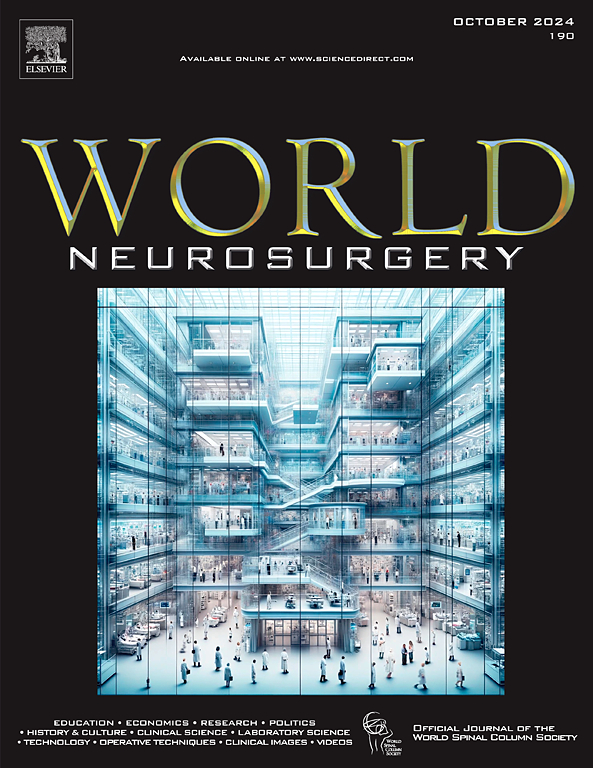使用眼眶分级系统分析成人莫亚莫亚病患者脑-颅动脉-血管新生术 (EDAS) 后血管再通的特征。
IF 2.1
4区 医学
Q3 CLINICAL NEUROLOGY
引用次数: 0
摘要
背景传统上,Matsushima 分级被用于评估 MMD 患者 EDAS 后 STA 的血管生长情况。然而,这种分级是主观的,而且容易产生测量变异。在此,我们提出了眼眶分级系统,用于量化 MMD 患者 EDAS 后从 STA 和/或 MMA 到大脑中动脉和前动脉的瘦血管和毛刺孔相关血管生长情况。方法参考眼眶骨性地标的两条平行垂直线,制定了解剖学分类,分为 0-3 级。结果纳入了 40 位 MMD 患者,中位年龄为 48 岁,大部分为女性(72.5%)。表现包括缺血性事件(65.0%)、出血(22.5%)和癫痫发作(7.5%)。大多数患者被归类为铃木≥IV(69.5%)。50名EDAS患者(89.9%)同时进行了钻孔(顶叶和额叶)。中位随访时间为 13.7 个月,侧支生长分级如下:0 级(6;10.8%)、1 级(12;21.4%)、2 级(23;41.1%)和 3 级(15;26.8%)。线性回归显示,眼眶分级系统与松岛分级的分布具有相似性(r=0.86;p<0.01)。结论眼眶分级系统与松岛分级一样,在确定术后缺血事件方面表现一致,并为有毛刺孔和无毛刺孔 EDAS 术后侧支血管生长提供了更实用、更客观的评估方法。本文章由计算机程序翻译,如有差异,请以英文原文为准。
Characterizing Revascularization after Encephalo-Duro-Arterio-Synangiosis (EDAS) in Adult Patients with Moyamoya Disease Using the Orbital Grading System.
BACKGROUND
The Matsushima Grade has traditionally been used to evaluate vessel ingrowth from the STA after EDAS for MMD-patients. However, this grading is subjective and prone to measurement variability. Herein, we propose the orbital grading system quantifying leptomeningeal and burr hole-related vessel-ingrowth from the STA and/or MMA to the middle and anterior cerebral arteries post-EDAS in MMD patients.
METHODS
An anatomical classification was developed by reference to two parallel vertical lines from the bony landmarks of the orbit, categorized from Grade 0-3. Regression models were used to compare clinical and functional outcomes of our grading system with the Matsushima scale.
RESULTS
Forty MMD patients, with median age of 48 years, mostly females (72.5%), were included. Presentation included ischemic events (65.0%), hemorrhage (22.5%), and seizures (7.5%). Most patients were categorized as Suzuki ≥ IV (69.5%). Fifty EDAS (89.9%) had concurrent burr holes placed (parietal and frontal regions). At a median follow-up of 13.7 months, collateral growth was graded as follows: grade 0 (6;10.8%), grade 1 (12;21.4%), grade 2 (23;41.1%) and grade 3 (15;26.8%). Linear regression showed similarities in the distribution between the orbital grading system and Matsushima grading (r=0.86;p<0.01). Ischemic events were fewer in hemispheres categorized as grade 2-3 compared to grade 0-1 (p=0.047) as well as in Matsushima grading A or B compared to C (p=0.047).
CONCLUSION
The orbital grading system demonstrated agreement in identifying postoperative ischemic events as the Matsushima grade and provides a more practical and objective evaluation of collateral vessel ingrowth after EDAS with and without burr-holes.
求助全文
通过发布文献求助,成功后即可免费获取论文全文。
去求助
来源期刊

World neurosurgery
CLINICAL NEUROLOGY-SURGERY
CiteScore
3.90
自引率
15.00%
发文量
1765
审稿时长
47 days
期刊介绍:
World Neurosurgery has an open access mirror journal World Neurosurgery: X, sharing the same aims and scope, editorial team, submission system and rigorous peer review.
The journal''s mission is to:
-To provide a first-class international forum and a 2-way conduit for dialogue that is relevant to neurosurgeons and providers who care for neurosurgery patients. The categories of the exchanged information include clinical and basic science, as well as global information that provide social, political, educational, economic, cultural or societal insights and knowledge that are of significance and relevance to worldwide neurosurgery patient care.
-To act as a primary intellectual catalyst for the stimulation of creativity, the creation of new knowledge, and the enhancement of quality neurosurgical care worldwide.
-To provide a forum for communication that enriches the lives of all neurosurgeons and their colleagues; and, in so doing, enriches the lives of their patients.
Topics to be addressed in World Neurosurgery include: EDUCATION, ECONOMICS, RESEARCH, POLITICS, HISTORY, CULTURE, CLINICAL SCIENCE, LABORATORY SCIENCE, TECHNOLOGY, OPERATIVE TECHNIQUES, CLINICAL IMAGES, VIDEOS
 求助内容:
求助内容: 应助结果提醒方式:
应助结果提醒方式:


